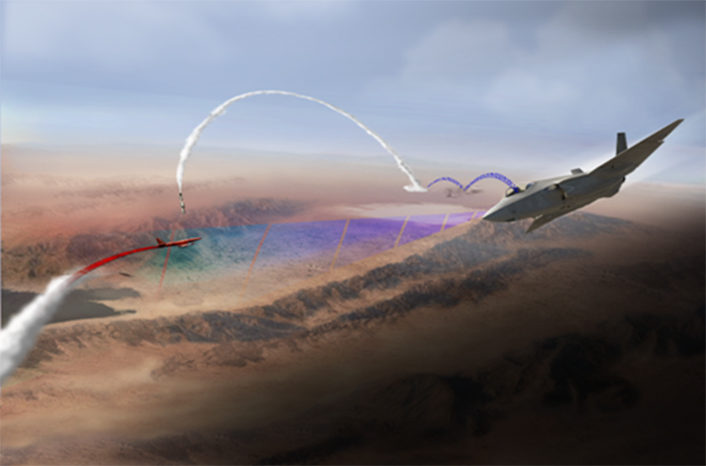According to the Russian MoD this video shows a Russian MiG-31 Foxhound taking down a cruise missile.
According to the press center of the Pacific Fleet of Russia, a Russian Navy MiG-31 Foxhound interceptor launched from the Kamchatka Peninsula, intercepted a supersonic cruise missile in the stratosphere during exercises that were conducted on the eve of the celebration of the Day of Naval Aviation.
The missile was launched from the water area of the Sea of Okhotsk at an altitude of more than 12 kilometers at a speed three times the speed of sound, Pravda new outlet reported.
The Mig-31 Foxhound is a two-seat Mig-25 Foxbat derivative in service since 1983.
Whilst the MiG-25 was built as a high-speed, high-altitude interceptor, capable of reaching the speed of Mach 3.2 to intercept American B-58 and B-70 bombers, the MiG-31 was designed to intercept the B-1B bomber, which was designed to operate at low-level, below the radar coverage.
The MiG-31 has quite good low-level capabilities (which MiG-25 does not) and is equipped with an advanced radar with look-down-shoot-down capability (needed to detect low-flying bombers), and data bus, allowing for coordinated attack with other fighters.
The production of the Mig-31, one of the world’s fastest tactical fighter in active service with top speed of Mach 2.83 and a range of 1,450 km, ended in the early 1990s, but the interceptor is being upgraded to extend its operative life up to the 2028 – 2030.
The Russian MiG-31BM jet, capable to carry up to four long-range R-33 missiles and four short-range R-77 missiles, was expected to carry a weapon able to shoot down space satellites; according to some sources, the ability to intercept a cruise missile, previously Kh-55 and now Kh-101, is something practiced by the Russian Foxhounds for years.
The video below, released by the Russian MoD, is said to show the test conducted on Jul. 17 (even though the actual interception of the cruise missile can’t be seen.)
Generally speaking, combat aircraft can intercept cruise missiles and engage them. However, such missiles are quite difficult to detect: they are optimised for low level flying through the Terrain Following capability, have a low radar cross-section and heat signature and, they are small.
This means that an inteceptor using a long-range missile from the right position and altitude might be able to do the job. But it shouldn’t be something too easy.
Testing conducted by the U.S. Navy has shown that shooting down cruise missiles, flying at low-level and high-speed is actually a pretty difficult task: on Sept. 12, 2016, a live test fire demonstration involved the integration of U.S. Marine Corps F-35B from the Marine Operational Test and Evaluation Squadron (VMX 1), based in Edwards Air Force Base, with existing Naval Integrated Fire Control-Counter Air (NIFC-CA) architecture.

The F-35B acted as an elevated sensor (to detect an over-the-horizon threat as envisaged for the F-22) that sent data through its Multi-Function Advanced Data Link to a ground station connected to USS Desert Ship (LLS-1), a land-based launch facility designed to simulate a ship at sea. Using the latest Aegis Weapon System Baseline 9.C1 and a Standard Missile 6, the system successfully detected and engaged the target: a test that proved how detecting, tracking and engaging cruise missiles requires cutting edge anti-surface and anti-air weapons.
On the other side it is somehow interesting to note that a rather old weapons system, the MiG-31, albeit operating a Passive Electronically Scanned Array (PESA) radar, can be able to intercept stealthy cruise missiles (like the Kh-101 reportedly used in some tests), with the support of an AWACS plane.
We don’t actually know the exact type of test the Russians conducted. For sure it wasn’t a low flying cruise missile like a Tomahawk, since this was reportedly flying in the “near space.”
The video below shows a past test when four MiG-31s, supported by an A-50 Mainstay, reportedly fired and hit a Kh-55 launched by a Tu-95 Bear.
“The cruise missile was destroyed at an altitude of 300 meters above the ground from a distance of 10 kilometers (6.2 miles) from the target,” the Russian MoD said in a statement, quoted by Russian-owned outlet Sputnik News, back in 2015.
Anyway, Russia has other weapons systems nominally capable of repelling cruise missile attacks, as well as jets and drones: the S-400 anti-aircraft defense is able to engage all types of aerial targets including aircraft (someone says even VLO – Very Low Observable ones), drones and ballistic and cruise missiles within the range of 250 miles at an altitude of nearly 19 miles.
Let us know what you think and know about the MiG-31 ability to intercept waves of cruise missiles.
Top image: file artwork by Pravda.ru
Related articles















